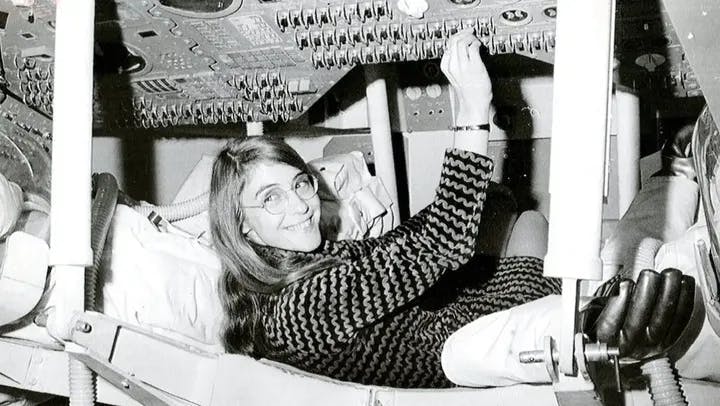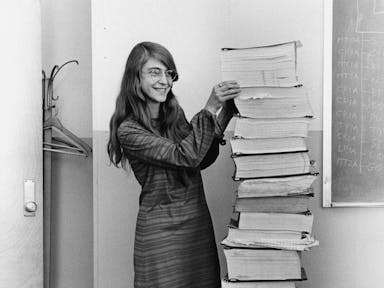Introducing Margaret Hamilton - NASA success story

If you couldn’t already tell from our brand and ambition, Rocketmaker’s founders Richard and Keith were hugely inspired by NASA's values when setting up the company. In fact, the origin of the visual identity was to blend the professionalism, collaboration and ambition of the NASA space program with a tongue and cheek retro sci-fi style from the 1950’s.
This theme is incorporated into most aspects of Rocketmaker’s identity from our logo, to our merchandise and interactive app. For our new office, we even had two large work “pods,” decorated to appear like rocket stages named “Venture III”. And each Rocketmaker's employee is illustrated as a fictional crew member as part of their company on-boarding.
Rocketmakers is so inspired by the work of NASA yet many people know very little about the incredible women who played a pivotal part in its achievements. This International Women's Day, we thought we would introduce you to four women who played a crucial role in historic space expeditions.
Over the course of the week, each day we have been shining a light on different female figures who each played their unique part in NASA’s work.
You can read the first two instalments of the series here and here.

Third, let’s introduce Margaret Hamilton, the woman who led the NASA software team that landed astronauts on the moon. She helped write the computer code for the command and lunar modules which were used on the Apollo missions to the Moon in the late 1960’s and early ’70’s. Apollo’s successful computing software was optimised to deal with unknown problems and to interrupt one task to take on a more important one. Not only that, she also created the term ‘software engineer’ to describe her work.
At the time, no schools taught software engineering, so the team members had to work out any problems on their own. Hamilton specifically concentrated on software to detect system errors and to recover information in a computer crash. This was crucial during the Apollo 11 mission in 1969, which took astronauts Neil Armstrong and Buzz Aldrin to the Moon.

Often in the evening or at weekends Hamilton would bring her young daughter, Lauren, into work with her. Hamilton describes, “One day, she was with me when I was doing a simulation of a mission to the moon. She liked to imitate me – playing astronaut. She started hitting keys and all of a sudden, the simulation started. Then she pressed other keys and the simulation crashed. She had selected a program which was supposed to be run prior to launch – when she was already “on the way” to the moon. The computer had so little space, it had wiped the navigation data taking her to the moon. I thought: my God – this could inadvertently happen in a real mission. I suggested a program change to prevent a pre launch program being selected during flight. But the higher-ups at MIT and NASA said the astronauts were too well trained to make such a mistake. Midcourse on the very next mission – Apollo 8 – one of the astronauts on board accidentally did exactly what Lauren had done. The Lauren bug! It created much havoc and required the mission to be reconfigured. After that, they let me put the program change in, all right.”
Margaret gives her top advice to young people today, “Don’t let fear get in the way and don’t be afraid to say “I don’t know” or “I don’t understand” – no question is a dumb question. And don’t always listen to the so-called experts!”
To celebrate International Women’s Day, we are putting a spotlight on four of NASA’s most successful women. Make sure to come back tomorrow to view our final instalment in the series.
First image credit: cosmosmagazine.com Second image credit: Smithsonian Magazine
At Rocketmakers we leverage our experience to build innovative software for companies of all sizes. If you have a vision for a project and you need a technical partner to help you design, develop and deploy it, get in touch: firstcontact@rocketmakers.com



